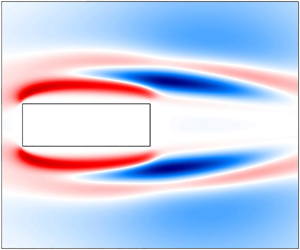Published online by Cambridge University Press: 28 October 2021

The primary instability of the flow past rectangular cylinders is studied to comprehensively describe the influence of the aspect ratio  $AR$ and of rounding the leading- and/or trailing-edge corners. Aspect ratios ranging between
$AR$ and of rounding the leading- and/or trailing-edge corners. Aspect ratios ranging between  $0.25$ and
$0.25$ and  $30$ are considered. We show that the critical Reynolds number (
$30$ are considered. We show that the critical Reynolds number ( $\textit {Re}_c$) corresponding to the primary instability increases with the aspect ratio, starting from
$\textit {Re}_c$) corresponding to the primary instability increases with the aspect ratio, starting from  $\textit {Re}_c \approx 34.8$ for
$\textit {Re}_c \approx 34.8$ for  $AR=0.25$ to a value of
$AR=0.25$ to a value of  $\textit {Re}_c \approx 140$ for
$\textit {Re}_c \approx 140$ for  $AR = 30$. The unstable mode and its dependence on the aspect ratio are described. We find that positioning a small circular cylinder in the flow modifies the instability in a way strongly depending on the aspect ratio. The rounded corners affect the primary instability in a way that depends on both the aspect ratio and the curvature radius. For small
$AR = 30$. The unstable mode and its dependence on the aspect ratio are described. We find that positioning a small circular cylinder in the flow modifies the instability in a way strongly depending on the aspect ratio. The rounded corners affect the primary instability in a way that depends on both the aspect ratio and the curvature radius. For small  $AR$, rounding the leading-edge corners has always a stabilising effect, whereas rounding the trailing-edge corners is destabilising, although for large curvature radii only. For intermediate
$AR$, rounding the leading-edge corners has always a stabilising effect, whereas rounding the trailing-edge corners is destabilising, although for large curvature radii only. For intermediate  $AR$, instead, rounding the leading-edge corners has a stabilising effect limited to small curvature radii only, while for
$AR$, instead, rounding the leading-edge corners has a stabilising effect limited to small curvature radii only, while for  $AR \geqslant 5$ it has always a destabilising effect. In contrast, for
$AR \geqslant 5$ it has always a destabilising effect. In contrast, for  $AR \geqslant 2$ rounding the trailing-edge corners consistently increases
$AR \geqslant 2$ rounding the trailing-edge corners consistently increases  $\textit {Re}_c$. Interestingly, when all the corners are rounded, the flow becomes more stable, at all aspect ratios. An explanation for the stabilising and destabilising effect of the rounded corners is provided.
$\textit {Re}_c$. Interestingly, when all the corners are rounded, the flow becomes more stable, at all aspect ratios. An explanation for the stabilising and destabilising effect of the rounded corners is provided.